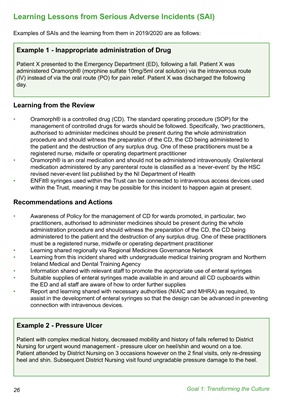
Learning Lessons from Serious Adverse Incidents (SAI)
Examples of SAIs and the learning from them in 2019/2020 are as follows:
Example 1 - Inappropriate administration of Drug
Patient X presented to the Emergency Department (ED), following a fall. Patient X was
administered Oramorph® (morphine sulfate 10mg/5ml oral solution) via the intravenous route
(IV) instead of via the oral route (PO) for pain relief. Patient X was discharged the following
day.
Learning from the Review
• Oramorph® is a controlled drug (CD). The standard operating procedure (SOP) for the
management of controlled drugs for wards should be followed. Specifically, 'two practitioners,
authorised to administer medicines should be present during the whole administration
procedure and should witness the preparation of the CD, the CD being administered to
the patient and the destruction of any surplus drug. One of these practitioners must be a
registered nurse, midwife or operating department practitioner
• Oramorph® is an oral medication and should not be administered intravenously. Oral/enteral
medication administered by any parenteral route is classified as a 'never-event' by the HSC
revised never-event list published by the NI Department of Health
• ENFit® syringes used within the Trust can be connected to intravenous access devices used
within the Trust, meaning it may be possible for this incident to happen again at present.
Recommendations and Actions
• Awareness of Policy for the management of CD for wards promoted, in particular, two
practitioners, authorised to administer medicines should be present during the whole
administration procedure and should witness the preparation of the CD, the CD being
administered to the patient and the destruction of any surplus drug. One of these practitioners
must be a registered nurse, midwife or operating department practitioner
• Learning shared regionally via Regional Medicines Governance Network
• Learning from this incident shared with undergraduate medical training program and Northern
Ireland Medical and Dental Training Agency
• Information shared with relevant staff to promote the appropriate use of enteral syringes
• Suitable supplies of enteral syringes made available in and around all CD cupboards within
the ED and all staff are aware of how to order further supplies
• Report and learning shared with necessary authorities (NIAIC and MHRA) as required, to
assist in the development of enteral syringes so that the design can be advanced in preventing
connection with intravenous devices.
Example 2 - Pressure Ulcer
Patient with complex medical history, decreased mobility and history of falls referred to District
Nursing for urgent wound management - pressure ulcer on heel/shin and wound on a toe.
Patient attended by District Nursing on 3 occasions however on the 2 final visits, only re-dressing
heel and shin. Subsequent District Nursing visit found ungradable pressure damage to the heel.
Goal 1: Transforming the Culture
26